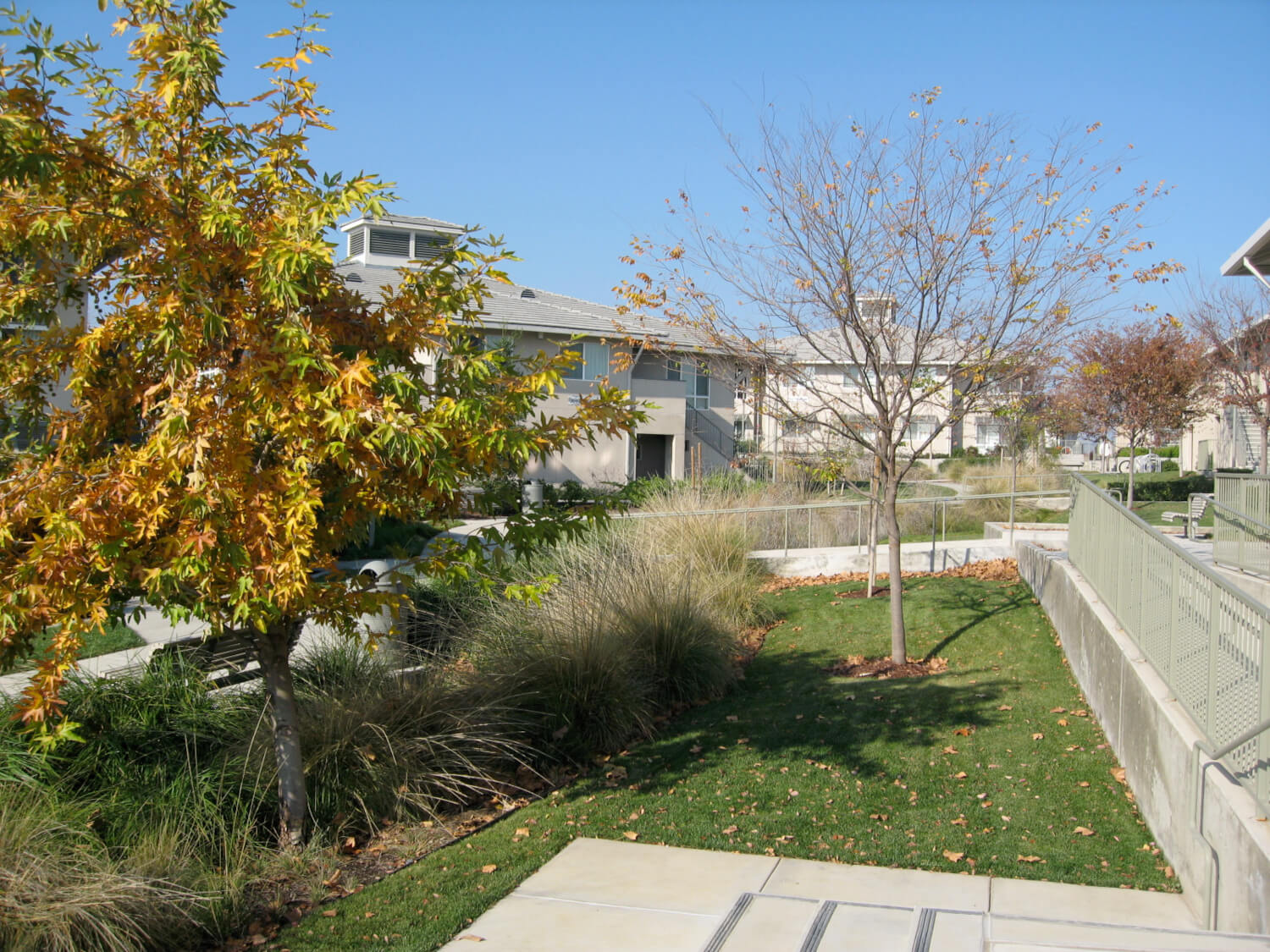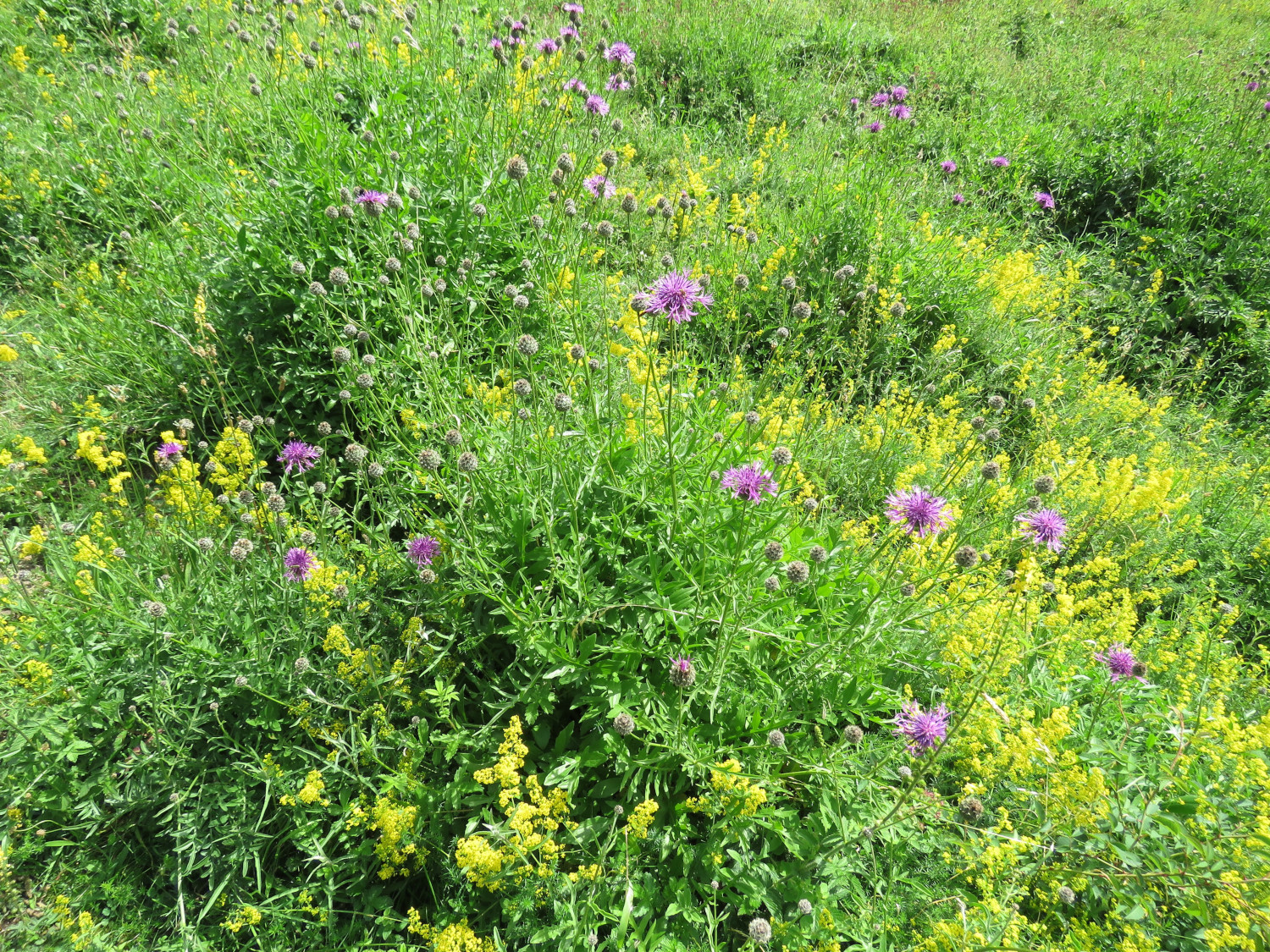Swot up on swale planting
For sustainable drainage and landscaping feature in one, the bioswale is an invaluable tool.
What is a swale?
Also known as swale drains, permaculture swales or bioswales, swales are broad, shallow and vegetated channels designed to promote sheet flow of water. Swales can collect, convey or store runoff, and allow infiltration where the soil conditions are appropriate. The robust plant matter acts to filter pollutants and particulate matter.
Traditionally, a swale trench follows the contour of the land, with a berm (a raised mound on the downhill side created from the excavated soil). However, it is also possible to install a swale on flat ground. The sides are generally gentle slopes.
Bioswales can be used in various ways, depending on the landscape conditions or project requirements, and planting them effectively depends on the habitats arising from their use. For example, where water is stored as or conveyed to a pond or water feature, wetland and meadow habitats may arise. Some permaculture swales are under-drained with a perforated pipe or filter drain. These are frequently used in housing developments to collect runoff at source, enhancing drainage, and resulting in dry grass channels which are visually acceptable for residents. On the other hand, conveyance swales are unlikely to be under-drained, and offer more opportunities for aesthetic and habitat enhancement.
Why do landscapers need to understand bioswale planting?
Bioswales are becoming increasingly common features of residential, commercial and municipal drainage schemes. This is in part due to the drive for greater sustainability, since bioswales help to control erosion and also form excellent habitats for, among others, dwindling amphibian species such as toads and newts. Swales can form part of a sustainable urban drainage system (SUDS).
Permaculture swales can also be a good economic choice. As well as being a low maintenance feature, bioswales are simple to build and reduce the need for dearer solutions such as kerbs, gratings or gullies. They are particularly suitable for treatment of runoff from small residential developments, parking areas and roads.

The characteristic shallow slope of a swale. – posted to Flickr as Recessed areas slow and infiltrate water into soil on site
From a planting perspective, swales create a rich, moist planting area, which can give landscapers the opportunity for a contrasting habitat for added visual interest. They can also double up on landscaping functionality, acting as privacy fences or windbreaks.
Because bio-swales must be perfectly level, they often resemble topographic lines, and this aesthetic can be used as a design feature (Indonesian rice paddies and Italian terraced vineyards, for instance, use the same idea).
How does a swale work?
In dry weather, a bioswale will hold little or no water, but after a period of heavy rainfall, the swale trench captures water. Because the trench follows the land contours, all points are at the same height above sea level, so the water rate is naturally slowed (the vegetation also helps to temper the flow). This helps to spread water evenly across the contour line and prevent flooding.
Sediment and organic matter will be filtered by the grass and other plants. The berm, a soft mound of loosely piled, non-compacted soil, acts as a retaining wall. In this manner, bioswale drainage helps to reduce erosion.
The use of check dams across the flow of a swale can further slow the water, in addition to reducing erosion by encouraging settling and infiltration. They also allow water to be retained easily at points of most need.
Over time, the storage of moisture creates long-term food and water security for both plants and animals, helping to establish a permanent habitat and growing system. Any trees planted on the swale will work in concert with the earthworks to open up the soil for more water and make the land drought proof – eventually no irrigation will be required.
What plants work best on and around a swale?
The types of plants that you select for the area around a bioswale depend very much on how the swale is used for drainage, the overall landscape aesthetic and purpose, and the habitats created.
As a general rule, a permaculture swale requires plants that can withstand times of drought in addition to waterlogged conditions. For trees, we recommend Betula utilis var. jacquemontii ‘Moonbeam’, a lovely, smaller variety of Himalayan Birch whose peeling silver-white bark adds distinction all year round. Red maple, weeping willow, river birch and ash are all excellent choices, too.
Fortunately, many grasses work well in swales. A particularly attractive variety which will thrive in the changing conditions is Miscanthus sinensis ‘Kleine Fontäne’, with its arching, silky leaves and wonderful array of colours throughout the year, from red flowers in summer to autumnal yellow and glimmering silver. You could also try Calamagrostis brachytricha or Deschampsia cespitosa.
Rosa rugosa ‘Roseraie de l’Hay’ is a fantastic flowering shrub to plant, with attractive autumn foliage and highly scented crimson flowers in summer and autumn. Other lovely options include Sambucus nigra ‘Black Beauty’ and Hydrangea arborescens ‘Annabelle’.
As far as perennials go, you can’t go wrong with Geranium Rozanne = ‘Gerwat’ with its spreading habit and its saucer-shaped violet flowers veined in purple. For contrasting colour, try the daylily Hemerocallis ‘Burning Daylight’, which boasts intensely coloured and fragranced trumpet-shaped flowers in cheering orange. Rudbeckias, Irises and Euphorbias are other great plants to use, and there are many others besides.
For meadow habitat, plants that will tolerate occasional flooding work well. These includes clover, most grasses and comfrey, many of which also function well as mat-forming vegetation for filtering runoff water. If the base of the swale is going to be a permanent or semi-permanent water feature, wetland plants will be required, such as reeds and sedges. Another fabulous option is winter dogwoods.

The rich violet blooms of Geranium ‘Rozanne’.
Planting the berm
The retaining wall needs to maintain its structural integrity and be protected from erosion, so plant deep-rooted perennials, herbs, and ground-covering plants to stabilize the soil. The berm is a great location for all plants that enjoy loose, rich soil and good drainage. This includes fruit trees, berry bushes, vines, perennial herbs and many flowers. They will all benefit from the organic matter that will gradually fill the swale basin, creating a rich reserve of nutrients for their roots.
Planting the base
Besides the plants already mentioned for wet soils, you may like to try perennials such as the erect, cardinal flower or bog sage (Lobelia cardinalis), Carex pendula and other sedges, and the stunning architectural arum or African lily (Zantedeschia aethiopica).
Purple coneflower (Echinacea purpurea), globeflower (Trollius europaeus), violets and primrose are lovely flowers to try, between them covering most of the year with their blooms.
Explore the Greenwood Tender Tool to discover further varieties for your swale landscape.

How and when to plant a bioswale
It is important to plant the berm as soon as the swale is ready (and level), to ward off any encroachment by unwanted plants. Unless it rains, water the plants after initial planting to help them become established.
Bioswales are an excellent place for planting multiple species in a small area. Aim to plant between six and 10 species, with two to three clumps per square metre. Ideally include a couple of year-old plants that have developed root systems. Avoid species such as Lavender and Azalea which cannot cope with ‘wet feet’.
Once planted, spread a layer of mulch over the swale before seeding with a wildflower grassland mix. Left to their own devices, these plants will grow and encourage bees, butterflies and other insects, helping the habitat to become established.
What maintenance does a bioswale need?
Maintenance of swales is simple and cost effective, consisting mainly of mowing to prevent grass falling over due to wind or water. Where meadow or wet swales develop, the vegetation is resistant to collapse and an annual or bi-annual cut will be sufficient to ensure the swale works effectively. Grass cuttings should be removed to avoid congestion of the trench. Maintenance can be tailored to the desired appearance of the swale so long as the flow and filtering capacity is retained.
Swales may require some light watering and weeding until the plants are fully established, and the berm may require further compacting soon after construction. Occasionally debris and sediment may need to be cleared or repairs made if erosion occurs.
Our friendly G-Team experts are always on hand if you have further questions about swale drainage, or advice on planting bioswales. Contact them via our web form or on 01243 939 551.

